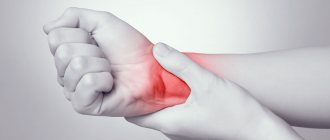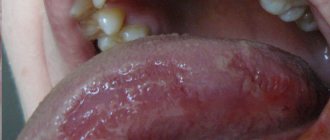A clinical sign manifested as a burning sensation in the penis is a common phenomenon in males.
Often men try to ignore this symptom, believing that the burning sensation will go away on its own.
There are not many reasons why a burning sensation in the penis may develop.
However, they are usually divided into two broad groups - non-communicable diseases and infectious diseases.
Clinical signs are dictated by the underlying pathological process.
A burning sensation in the penis is not often the only symptom.
It may be accompanied by redness of the prepuce, testicles, soreness, and rashes on the surface of the penis.
Itching or burning in the genital area usually indicates a sexually transmitted disease.
A burning sensation in the penis occurs with various types of STDs - herpes, gonorrhea, Trichomonas, etc. and may occur in combination with other symptoms.
Burning and itching rarely go away on their own and require medical treatment.
A urologist or venereologist will be able to find out the cause of these symptoms and make an accurate diagnosis after the diagnostic measures that the patient undergoes.
Phimosis, narrowing of the foreskin
Phimosis is a terrible disease. A predisposing factor in the development of posthitis is congenital or acquired narrowing of the opening of the foreskin - phimosis . With a disease such as diabetes mellitus, or in the elderly and elderly, phimosis of the penis can develop even with regular high-quality washing of the glans. With balanitis, the foreskin is hyperemic and swollen, erosions and purulent plaque appear on its inner surface and head, a guy or a man is bothered by itching and pain when trying to have sexual intercourse. Sometimes the head is not exposed , the penis swells, becomes hyperemic, redness is noted, and lymphadenitis of the inguinal lymph nodes appears. A severe complication of phimosis is gangrene of the penis , which can result in complete tissue necrosis. The man is left without a penis. And this is already a difficult situation!
Diagnostics
Patients with inflammatory diseases are examined by a urologist-andrologist. If signs of STIs and dermatological pathologies are detected, patients are referred to a dermatovenerologist. Determining the nature of the disease is based on complaints, objective examination data and laboratory tests:
- Questioning, inspection.
During the conversation, the moment of symptom onset, the presence of other manifestations, and the dynamics of their development over time are clarified. In inflammation, identifying the causative factor plays a significant role. During examination, the doctor identifies swelling, hyperemia, erosion, rashes and other changes, assesses their localization and prevalence. - Lab tests.
Microscopy is performed to confirm inflammation. To clarify the nature of the pathogen, PCR and inoculation on nutrient media are performed. If scabies is suspected, a scraping examination is performed. For dermatitis, a general blood test is prescribed to confirm eosinophilia, the concentration of immunoglobulins is determined, and allergy tests are performed.
If there are indications, consultations with doctors of various profiles are prescribed to identify provoking pathologies. Patients can be referred to an endocrinologist, therapist, phthisiatrician, and other specialists.
Postitis symptoms, signs in boys, guys and men
What are the main symptoms and signs of posthitis in men and boys? Which posthitis clinic ? Itching of the glans penis . Burning sensation on the head of the penis .
Pain in the head of the penis. Swelling, redness of the head of the penis. Pain, pain, discomfort during sex in the area of the head of the penis. Difficulty opening the head. Decreased sensitivity of the head. Weakening of erection. Cracks in the foreskin. Ulcers and ulcers on the head.
What tests should I take if I suspect chlamydia?
Chlamydia trachomatis has some complications because the pathogen is intracellular.
It is difficult to culture and serological tests will not provide meaningful results.
Thus, chlamydia culture and ELISA will indicate the presence of chlamydia with an accuracy of only 60-70%.
The only informative method that can detect infection with 100% accuracy is PCR.
Chlamydia in men can be effectively treated with antibiotics.
The most common treatment consists of Azithromycin therapy.
Patients who have been infected through anal intercourse are prescribed Doxycycline.
The drugs are taken daily for 5-7 days.
Possible side effects of treatment: nausea, abdominal pain, diarrhea.
In case of infection with chlamydia, treatment is also prescribed to the sexual partner.
During the entire course of therapy, it is recommended to abstain from intimacy.
What is the most effective prevention of chlamydia?
There is only one truly effective preventive measure.
This includes regular condom use and annual STI testing.
Redness on the glans, glans in men, boys and itching of the foreskin
If you notice severe redness on the glans , slight redness of the glans in men and boys, incomprehensible redness of the head of the penis , noticeable redness of the head of the penis, redness on the glans and itching of the foreskin, redness around the head of the skin of the head of the penis, redness on the head of the penis, near the glans, under the head, on the head of a child boy, child, redness of the tip of the head after sex, white coating, slight redness, flaking of the head, under the head of the penis, around the head of the penis, edge of the head, skin, redness and dryness, rash, itching, burning, call doctor so that he can prescribe effective treatment.
There are contraindications. Specialist consultation is required.
Photo: Shmeljov | Dreamstime.com\Dreamstock.ru. The people depicted in the photo are models, do not suffer from the diseases described and/or all similarities are excluded.
Related posts:
Balanitis, treatment of balanitis in Saratov, how to treat balanitis
Cystitis, symptoms, treatment of cystitis in Saratov, how to treat inflammation of the bladder
Treatment of the prostate in men in Saratov, Russia: prostate gland, prostatitis, adenoma
Epididymitis, acute, chronic: treatment, how to treat inflammation of the epididymis, pain in the testicles
Testicular orchitis, testicular inflammation, orchitis treatment
Comments ()
Burning sensation in the penis due to gonorrhea
Gonorrhea, also known as "gonorrhea".
It is a common STI among men, particularly gay and bisexual men.
The causative agents of the pathology are gonococci.
These are gram-negative, paired microorganisms that can cause infections in the urethra, anus and/or throat mucosa.
In men, gonorrhea first appears as urethritis.
Urethritis is expressed by the discharge of yellow-greenish pus (often in the morning), painful urination, and a slight increase in body temperature.
Many patients note a burning sensation in the penis after anal or vaginal sex.
When the pathogen rises higher up the urethra, inflammation of the epididymis and prostate may occur.
Subsequently, occlusion of the seminiferous tubules of the epididymis develops, which leads to infertility.
Gonococci, the causative agents of gonorrhea, can spread through the bloodstream throughout the body.
At the same time, causing secondary diseases such as joint inflammation, tendinitis, conjunctivitis, eye irritation or dermatitis.
There may be no symptoms.
Therefore, the only way for a person who has been exposed to gonorrhea to determine whether they are infected is to undergo laboratory testing.
Gonorrhea can be diagnosed using a urine test or swabs taken from the urethra, anus, and throat mucosa.
Gonorrhea is often accompanied by chlamydia.
Therefore, it is recommended to take a comprehensive test for STIs, and not for individual sexually transmitted diseases
In uncomplicated cases, the usual treatment is a single dose of a medicine such as Ceftriaxone given intramuscularly or Cefixime.
Additionally, a single dose of Azithromycin tablet is prescribed.
These are effective antibiotics and fast-acting drugs, but may cause some side effects from the gastrointestinal tract.
In some cases, after gonorrhea is treated, symptoms may remain for some time.
As a rule, this phenomenon is accompanied by postgonococcal urethritis.
This condition is usually caused by chlamydia that has not responded to antibiotic therapy.
In this case, an additional antibiotic is prescribed aimed at destroying Chlamydia trachomatis.
Organ injury
Soreness can be caused by the fact that a person has too intense sex life or masturbates. At the same time, the penis can hurt even if you simply touch it when visiting the toilet.
Pain also occurs due to the fact that the partner does not have enough discharge during intimacy and insertion of the penis is difficult. To reduce the risk of injury to the organ, for example, to avoid rupture of the frenulum, you need to use lubricant.
Injuries can be thermal - getting a burn, frostbite of the penis. Such accidents should not be ignored or treated at home. You definitely need to go to a surgeon.
Among mechanical injuries, head contusions are common. In this case, the pain is severe, the organ swells, there are bruises on it, and obvious difficulties arise when using the toilet. A urologist together with a surgeon will help.
Soreness can be caused by urolithiasis, a tumor after incorrect circumcision, or due to priapism. The latter pathology is manifested by an incessant erection.
Only medical assistance will help minimize the consequences. If you have pain, you need to go to the doctor.
Treatment
Treatment of diseases accompanied by itching of the penis is conservative in the vast majority of cases. Corticosteroids and antihistamines are used to relieve itching. The list of other treatment measures depends on the type of pathology:
- Balanitis and balanoposthitis.
The patient is advised to strictly follow the rules of hygiene. Taking into account the nature of the pathogen, antibacterial, antifungal or antiviral agents of general and local action are prescribed. Antiseptic irrigation is used. - Dermatitis.
For common processes, detoxification therapy is carried out. Hormonal ointments are applied locally, the wet areas are treated with antiseptics, infusion of oak bark or chamomile. Pustules and vesicles are opened, the exposed surfaces are dried with aniline dyes. For severe itching, it is recommended to take sedatives. - Scabies.
Treatment of the entire body with special emulsions, creams or sprays is indicated in accordance with the established scheme. Then the underwear is changed, and after 2 days the course is repeated. After completion of treatment, clothing and furniture are wiped with an antiseptic or irradiated with a UV lamp.
Surgical interventions are required for patients with complicated balanoposthitis. For cicatricial phimosis, circumcision is performed. If there is a predisposing factor in the form of narrowing of the foreskin, preputioplasty may be recommended. With the development of precancerous and cancerous diseases, the scope of the operation is determined individually.
How to use ointment for mycosis of the penis?
Ointment for mycosis of the penis is used for about 7 days. You need to rub the drug in several times a day, as recommended in the leaflet. Special hygiene should be observed, washing hands thoroughly before and after applying the ointment. If symptoms do not resolve within one week, systemic therapy may be required.
Especially in this case, it is important to read the dosage instructions carefully. Fluconazole is used for different types of mycoses in different doses and time intervals. To treat penile candidiasis, take only one tablet containing 150 mg of the active substance. Unlike vaginal yeast infections, maintenance doses are not used.
ONLINE REGISTRATION at the DIANA clinic
You can sign up by calling the toll-free phone number 8-800-707-15-60 or filling out the contact form. In this case, we will contact you ourselves.
If you find an error, please select a piece of text and press Ctrl+Enter
Misconceptions about healing
The picture of unexpected pain and the listed symptoms in the urethra often takes a man by surprise.
In attempts to eliminate unpleasant sensations, ointments and tablets available in the home medicine cabinet are used.
Sometimes such methods can actually relieve pain and reduce the intensity of other unpleasant symptoms. But in addition to the occasional medications that help with troubles, you will need to do a number of diagnostic procedures and only then create a comprehensive treatment.
The misconception about curing burning and itching in the urethra leads to the transition of the pathology to the chronic stage, after which the problems are much more difficult to eliminate, and the disease becomes advanced.
The situation can bring harm to a man’s health if some of the symptoms have been eliminated, after which a visit to the doctor is made and the full picture of the disease is kept silent.
The disease will not be cured unless the doctor prescribes a proper examination and the necessary medications.
This can cause significant damage to the patient’s health if the remaining problems develop into an advanced form.
Note
There are no special signs indicating the cause of the itching. Therefore, in any case when itching occurs, a thorough examination is necessary.
Reference and information material
Author of the article
Khaldin Alexey Anatolievich
Dermatovenerologist, clinical immunologist, MD, professor
Loading...
Take other surveys







